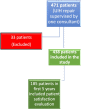The Impact of Body Mass Index on Local Anaesthetic Inguinal Hernia Repair
- PMID: 37065380
- PMCID: PMC10102715
- DOI: 10.7759/cureus.36163
The Impact of Body Mass Index on Local Anaesthetic Inguinal Hernia Repair
Abstract
Background: Open mesh repair of inguinal hernia is acceptable and can be performed under local anaesthesia (LA). Individuals with high BMI (Body Mass Index) have often been excluded from LA repairs for varying reasons including safety concerns. Open repair of unilateral inguinal hernia (UIH) amongst individuals with different BMI groups was studied. Its safety profile was investigated using LA volume and length of operation (LO) as endpoints. Operative pain and patient satisfaction were also evaluated.
Patients and methods: A total of 438 adult patients were studied having excluded underweight patients, those requiring any additional intra-operative analgesia, multiple procedures, or records with incomplete data. Operative pain, patient satisfaction, LO and LA volume were retrospectively studied from the existing data from clinical and operative notes.
Results: It was a predominantly male population (93.2% males) with an age range of 17-94 years peaking in the 60-69 years age group. BMI ranged 19-39 kg/m2 with BMI above normal at 62.8%. LO was 13-100 minutes (average 37 mins {SD = 12}) utilising an average LA volume of 45 ml (SD = 11) per patient. Across BMI groups, no significant difference in LO (P = 0.168) or patient satisfaction (P = 0.388) was seen. Although LA volume (P = 0.011) and pain score (P<0.001) demonstrated statistically significant differences, these did not appear to be clinically relevant. Over 90% in each BMI group experienced mild or no pain and with severe pain reported in only one patient in the entire population. Overall, LA volume required per patient was low and dosage was safe in all BMI groups with significant proportion (89%) of patients evaluated for satisfaction rating their experience ≥ 90 out of 100.
Conclusion: LA repair is safe and well tolerated irrespective of BMI. BMI is not a viable reason for exclusion of obese/overweight individuals from LA repair.
Keywords: bmi; inguinal hernia; lichtenstein; local anaesthesia; unilateral.
Copyright © 2023, Olugbemi et al.
Conflict of interest statement
The authors have declared that no competing interests exist.
Figures
Similar articles
-
Local anaesthetic repair of paraumbilical hernia as a safe option across a range of body mass indices.Ann R Coll Surg Engl. 2020 Apr;102(4):290-293. doi: 10.1308/rcsann.2020.0002. Epub 2020 Jan 17. Ann R Coll Surg Engl. 2020. PMID: 31951146 Free PMC article.
-
Local anesthetic hernia repair in overweight and obese patients.World J Surg. 2009 Jan;33(1):138-41. doi: 10.1007/s00268-008-9743-1. World J Surg. 2009. PMID: 18841412
-
Local anaesthetic repair of uncomplicated paraumbilical hernia without sedation: peri-operative pain and patient satisfaction.Hernia. 2013 Aug;17(4):499-504. doi: 10.1007/s10029-013-1085-8. Epub 2013 Mar 31. Hernia. 2013. PMID: 23543335
-
Inguinal hernia repair: anaesthesia, pain and convalescence.Dan Med Bull. 2003 Aug;50(3):203-18. Dan Med Bull. 2003. PMID: 13677240 Review.
-
TEP for elective primary unilateral inguinal hernia repair in men: what do we know?Hernia. 2019 Jun;23(3):439-459. doi: 10.1007/s10029-019-01936-6. Epub 2019 May 6. Hernia. 2019. PMID: 31062110 Free PMC article.
Cited by
-
Risk factors and clinical impact of seroma formation following laparoscopic inguinal hernia repair: a retrospective study.BMC Surg. 2024 Oct 1;24(1):274. doi: 10.1186/s12893-024-02574-1. BMC Surg. 2024. PMID: 39354429 Free PMC article.
-
Critical values for body mass index related to morbidity in high-volume low-complexity general surgery: a systematic review and meta-analysis.Ann R Coll Surg Engl. 2025 Apr;107(4):242-252. doi: 10.1308/rcsann.2024.0057. Epub 2024 Aug 14. Ann R Coll Surg Engl. 2025. PMID: 39141001 Free PMC article.
References
-
- Incidence of inguinal hernia and its type in a study in a semiurban area in Andhra Pradesh, India. Rahul BG, Ravindranath GG. Int Surg J. 2016;3:1946–1949.
-
- Hernias: inguinal and incisional. Kingsnorth A, LeBlanc K. Lancet. 2003;362:1561–1571. - PubMed
LinkOut - more resources
Full Text Sources



